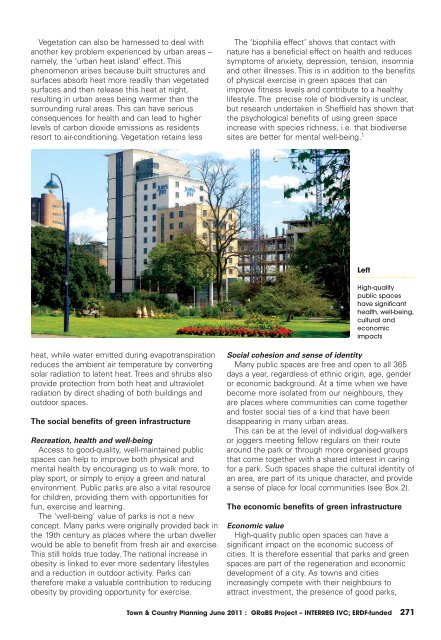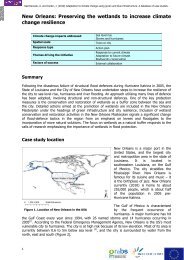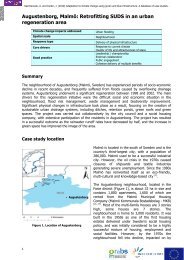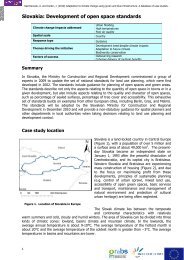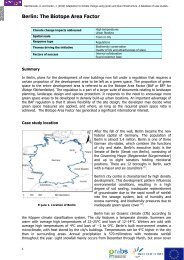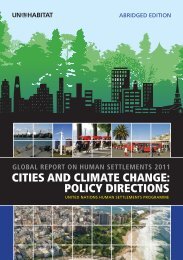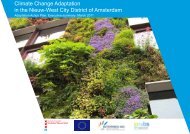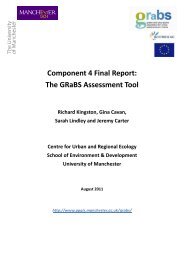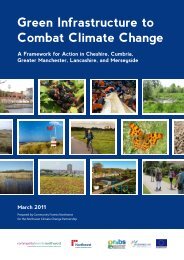Download - GRaBS
Download - GRaBS
Download - GRaBS
Create successful ePaper yourself
Turn your PDF publications into a flip-book with our unique Google optimized e-Paper software.
Vegetation can also be harnessed to deal with<br />
another key problem experienced by urban areas –<br />
namely, the ‘urban heat island’ effect. This<br />
phenomenon arises because built structures and<br />
surfaces absorb heat more readily than vegetated<br />
surfaces and then release this heat at night,<br />
resulting in urban areas being warmer than the<br />
surrounding rural areas. This can have serious<br />
consequences for health and can lead to higher<br />
levels of carbon dioxide emissions as residents<br />
resort to air-conditioning. Vegetation retains less<br />
The ‘biophilia effect’ shows that contact with<br />
nature has a beneficial effect on health and reduces<br />
symptoms of anxiety, depression, tension, insomnia<br />
and other illnesses. This is in addition to the benefits<br />
of physical exercise in green spaces that can<br />
improve fitness levels and contribute to a healthy<br />
lifestyle. The precise role of biodiversity is unclear,<br />
but research undertaken in Sheffield has shown that<br />
the psychological benefits of using green space<br />
increase with species richness, i.e. that biodiverse<br />
sites are better for mental well-being. 1<br />
Left<br />
High-quality<br />
public spaces<br />
have significant<br />
health, well-being,<br />
cultural and<br />
economic<br />
impacts<br />
heat, while water emitted during evapotranspiration<br />
reduces the ambient air temperature by converting<br />
solar radiation to latent heat. Trees and shrubs also<br />
provide protection from both heat and ultraviolet<br />
radiation by direct shading of both buildings and<br />
outdoor spaces.<br />
The social benefits of green infrastructure<br />
Recreation, health and well-being<br />
Access to good-quality, well-maintained public<br />
spaces can help to improve both physical and<br />
mental health by encouraging us to walk more, to<br />
play sport, or simply to enjoy a green and natural<br />
environment. Public parks are also a vital resource<br />
for children, providing them with opportunities for<br />
fun, exercise and learning.<br />
The ‘well-being’ value of parks is not a new<br />
concept. Many parks were originally provided back in<br />
the 19th century as places where the urban dweller<br />
would be able to benefit from fresh air and exercise.<br />
This still holds true today. The national increase in<br />
obesity is linked to ever more sedentary lifestyles<br />
and a reduction in outdoor activity. Parks can<br />
therefore make a valuable contribution to reducing<br />
obesity by providing opportunity for exercise.<br />
Social cohesion and sense of identity<br />
Many public spaces are free and open to all 365<br />
days a year, regardless of ethnic origin, age, gender<br />
or economic background. At a time when we have<br />
become more isolated from our neighbours, they<br />
are places where communities can come together<br />
and foster social ties of a kind that have been<br />
disappearing in many urban areas.<br />
This can be at the level of individual dog-walkers<br />
or joggers meeting fellow regulars on their route<br />
around the park or through more organised groups<br />
that come together with a shared interest in caring<br />
for a park. Such spaces shape the cultural identity of<br />
an area, are part of its unique character, and provide<br />
a sense of place for local communities (see Box 2).<br />
The economic benefits of green infrastructure<br />
Economic value<br />
High-quality public open spaces can have a<br />
significant impact on the economic success of<br />
cities. It is therefore essential that parks and green<br />
spaces are part of the regeneration and economic<br />
development of a city. As towns and cities<br />
increasingly compete with their neighbours to<br />
attract investment, the presence of good parks,<br />
Town & Country Planning June 2011 : <strong>GRaBS</strong> Project – INTERREG IVC; ERDF-funded 271


